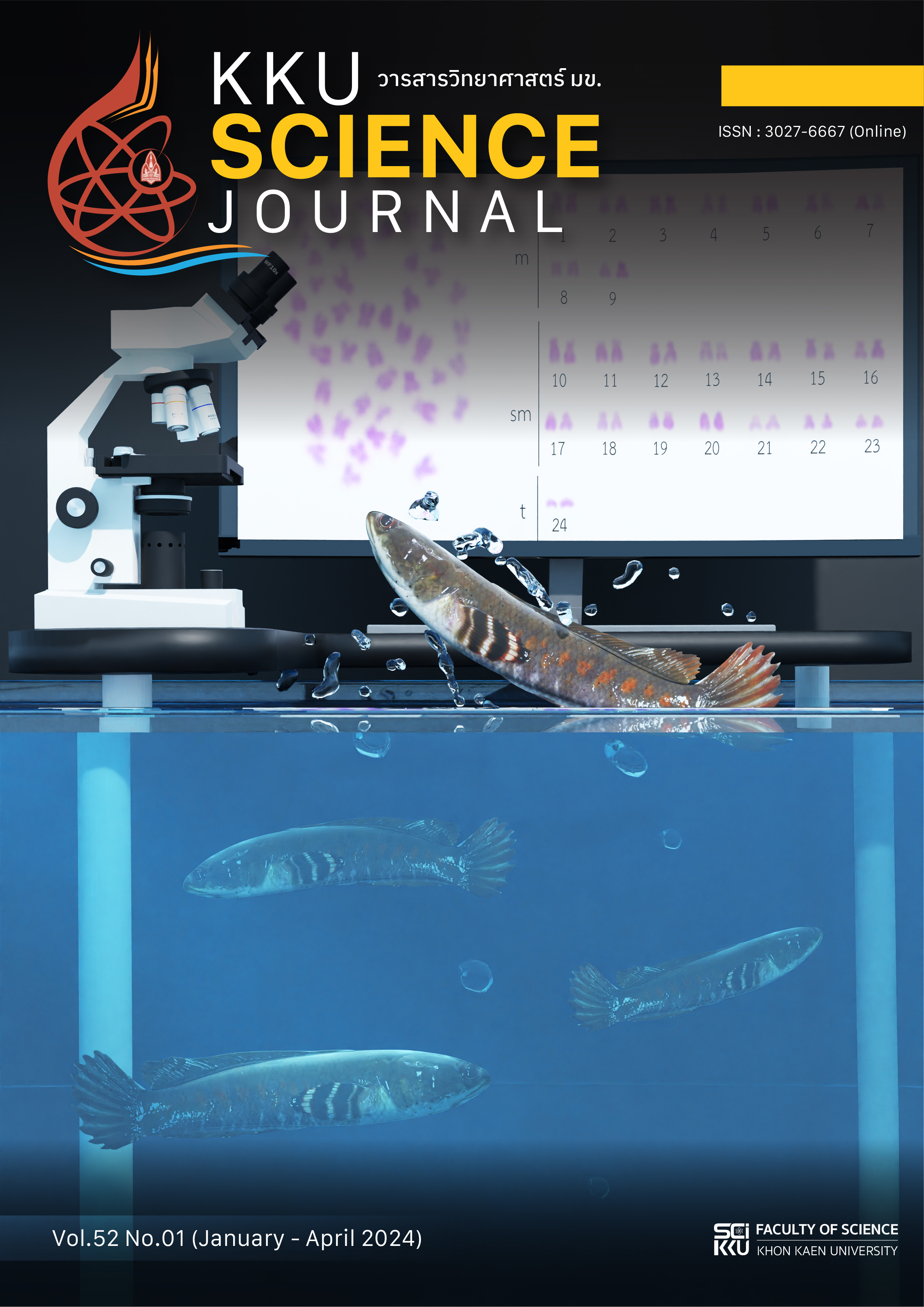Use of Sago Starch and Konjac Powder in Boba Pearl
Main Article Content
Abstract
This research aimed to increase the value of sago starch by using it in the boba pearls. Optimal study of the formulation of boba pearls from sago starch and konjac powder was carried out. Boba pearls of 10 formulations consisted of sago starch (45 - 54%), tapioca flour (26 - 35%), konjac powder (3%) and 50% (w/v) sucrose syrup (17%). The result of sensory evaluation showed that the optimal formulation for producing boba pearls contained 51% sago starch, 29% tapioca flour, 3% konjac powder, and 17% syrup. The liking scores of color, odor, texture and overall liking were the highest. The modified boba pearls were dried by using a hot air oven. The dried boba pearls presented 0.60 0.13 of water activity and 11.41
0.38% of moisture content. In addition, 100 grams of dried boba pearl provided a total of 367 kilocalories of energy, 4.40 grams of dietary fiber, 9.35 micrograms of vitamin A RE, 23.4 milligrams of calcium and 0.28 milligrams of iron. The dried boba pearls, which were stored at 25 ºC for 7 days, received similar liking scores in all attributes compared to the first-day boba pearls. The research could be applied to food entrepreneurs for commercial use.
Article Details

This work is licensed under a Creative Commons Attribution-NonCommercial-NoDerivatives 4.0 International License.
References
กรรณิการ์ อ่อนสำลี และศิริลดา ศรีกอก. (2565). การใช้ผงบุกในผลิตภัณฑ์กัมมี่เยลลี่มัลเบอร์รี่. วารสารมหาวิทยาลัยเทคโนโลยีราชมงคลอีสาน ฉบับวิทยาศาสตร์และเทคโนโลยี 15(3): 107 - 120.
ฉวีวรรณ พันธุ์ไชยศรี, อุมาพร ศิริพินทุ์ และวิจิตรา แดงปรก. (2551). การผลิตกุนเชียงไขมันต่ำจากเจลบุก. วารสารอาหาร 38(4): 355 - 362.
ตวงรัตน์ สนนาค, รวิสรา ชื่นประไพ, ดวงกมล แสงธีรกิจ และปาริสุทธิ์ เฉลิมชัยวัฒน์. (2566). ผลของแซนแทนกัมและกัวร์กัมต่อคุณภาพของเม็ดไข่มุกจากการใช้แป้งข้าวกล้องงอกและแป้งข้าวเหนียวดำงอกทดแทนแป้งมันสำปะหลัง. วารสารวิชาการและวิจัยมหาวิทยาลัยราชภัฏพระนคร 17(1): 14 - 26.
นงลักษณ์ สุวรรณพันธ์. (2558). การทำแป้งสาคูจากต้นสาคูด้วยภูมิปัญญาแบบชาวบ้าน. แหล่งข้อมูล: https://www.rakbankerd.com/agriculture/page.php?id=9397&s=tblplant. ค้นเมื่อวันที่ 22 มกราคม 2567.
นพรัตน์ บำรุงรักษ์. (2532). สาคู: พืชที่มีศักยภาพของภาคใต้. วารสารรูสมิแล 12(3): 25 - 29.
นิพนธ์ ใจปลื้ม, กัจนัสม์ พาพล และอัจฉรา ใจปลื้ม. (2552). การสร้างต้นแบบนำร่องป่าปาล์มสาคูในพื้นที่ชุ่มน้ำ. ใน: รายงานการประชุมทางวิชาการของมหาวิทยาลัยเกษตรศาสตร์ ครั้งที่ 47. มหาวิทยาลัยเกษตรศาสตร์; กรุงเทพฯ. 25 - 32.
นิพนธ์ ใจปลื้ม, อัจฉรา ใจปลื้ม และจรีวรรณ จันทร์คง. (2561). ความเป็นไปได้ในการพัฒนาผลิตภัณฑ์ปาล์มสาคูเชิงพาณิชย์. วารสารวิจัยมหาวิทยาลัยเทคโนโลยีราชมงคลศรีวิชัย 10(1): 97 - 111.
บุศราภา ลีละวัฒน์, รัฐนันท์ ติลกกุล และมนัสนันท์ ใบคุณากร. (2563). การพัฒนาเม็ดไข่มุกจากข้าวก่ำ. วารสารวิทยาศาสตร์และเทคโนโลยี 28(3): 455 - 465.
พนม อินทฤทธิ์. (2561). การผลิตและแปรรูปแป้งสาคูในจังหวัดนครศรีธรรมราช ตรังและพัทลุง. รายงานวิจัยคณะวิทยาศาสตร์และเทคโนโลยี, มหาวิทยาลัยเทคโนโลยีราชมงคลศรีวิชัย. นครศรีธรรมราช. 1 - 82.
ไพโรจน์ วิริยจารี. (2545). การประเมินทางประสาทสัมผัส. เชียงใหม่: คณะอุตสาหกรรมเกษตร มหาวิทยาลัยเชียงใหม่. 1 - 574.
ไพโรจน์ วิริยจารี. (2555). การออกแบบการทดลอง (experimental design). เชียงใหม่: คณะอุตสาหกรรมเกษตร มหาวิทยาลัยเชียงใหม่. 1 - 437.
วรวีร์ องค์วิเศษไพบูลย์. (2562). กลยุทธ์ของธุรกิจชานมไข่มุกแบบจัดส่งในกรุงเทพมหานคร. วิทยาศาตรมหาบัณฑิต, มหาวิทยาลัยธรรมศาสตร์. กรุงเทพฯ. 89 หน้า.
สมศักดิ์ เหล่าเจริญสุข. (2530). การใช้ลำต้นสาคูเลี้ยงสัตว์. วารสารวิทยาศาสตร์และเทคโนโลยี 2(1): 35 - 40.
สำนักงานมาตรฐานผลิตภัณฑ์อุตสาหกรรม. (2547). มาตรฐานผลิตภัณฑ์ชุมชน แป้งสาคู มผช.308/2547. แหล่งข้อมูล: https://fic.nfi.or.th/law/upload/file1/TH_1198.pdf. ค้นเมื่อวันที่ 23 มกราคม 2567.
สุภางค์ เรืองฉาย. (2566). การใช้แป้งดัดแปรและผงปรุงรสเพื่อพัฒนาผลิตภัณฑ์เมล็ดมะม่วงหิมพานต์อบ. วารสารวิทยาศาสตร์ มข. 51(1): 1 - 8.
หทัยทัต มณีชาติ. (2562). พฤติกรรมการบริโภคและความพึงพอใจต่อปัจจัยส่วนประสมทางการตลาดชานมไข่มุก กรณีศึกษา Tiger Sugar. วารสารศาสตรมหาบัณฑิต, คณะวารสารศาสตร์และสื่อสารมวลชน มหาวิทยาลัยธรรมศาสตร์. กรุงเทพฯ. 127 หน้า.
อภิรดา พรปัญญวิชญ์. (2565). ผลของอุณหภูมิและเวลาในการอบแห้งต่อองค์ประกอบทางเคมีของผงบุกและการนำไปใช้ในไส้กรอกอิมัลชัน. วารสารเกษตรพระจอมเกล้า 40(1): 58 – 67.
Ahmad, F.B.F and Peter A.W. (1998). Rheological properties of sago starch. Journal of Agricultural and Food Chemistry 46(10): 4060 - 4065.
AOAC International. (1993). Methods of analysis for nutrition labeling. Arlington, Virginia.
AOAC International. (2019). Official methods of analysis by the Association of Official Analytical Chemists. (20th ed). Maryland, U.S.A.
ASEAN Network of Food Data Systems. (2011). ASEAN manual of food analysis. (1st ed). Bangkok: Institute of Nutrition, Mahidol University THAILAND. 81 - 87 and 103 - 108.
Konuma, H., Rosa R. and Somsak B. (2012). Adding value to underutilized food resources: substituting wheat flour with sago starch in cookie formulations. Journal of Agricultural Technology 8(3): 1067 - 1077.
Ratasrisomboon, N. (2016). The effect of modified starch onto the quality of tapioca pearl under low temperature storage in sucrose syrup. Bachelor of Science in Biotechnology, Assumption University. Bangkok. 36 pp.
Sim, S.L., Oates, C.G. and Wong, H.A. (1991). Studies on sago starch. part I: characterization and comparison of sago starches obtained from Metroxylon sagu processed at different times. Starch 43(12): 459 - 466.


